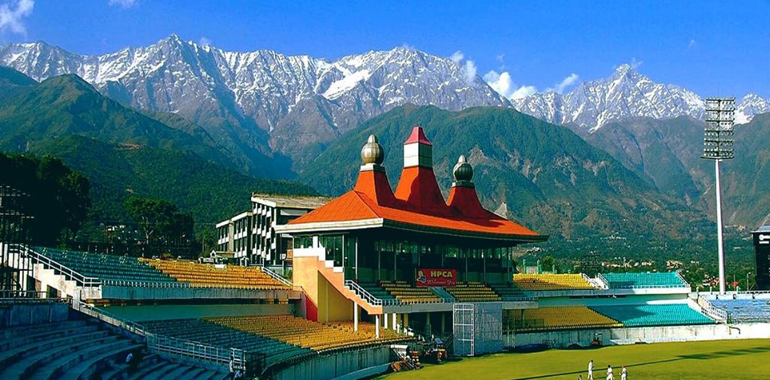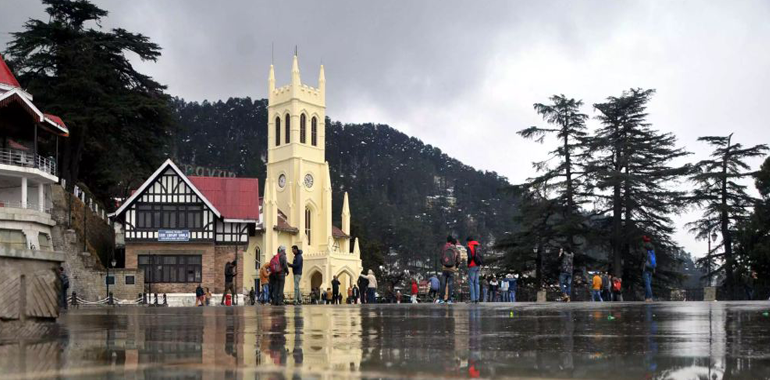Nature's abode-Himachal Pradesh- is a land that has everything: Nature and scenic landscapes, the mighty Himalayas, culture, religion and heritage, flora and fauna, adventures, people, unbeatable hospitality, and mouth-watering cuisine. 'Unforgettable Himachal,' called Himachal Pradesh, is a treat for your mind, soul, and eyes. Exploring the state, you might realize that it is a treasure trove of nature where you can lose and simultaneously find yourself. At present, Himachal Pradesh flourishes in the field of tourism. Till the 19th century, the tourism area was limited to pilgrims' movement to the spiritual destinations around the hills. After the advent of British and colonial rule, tourism was developed, so the British settled here during summer. The British also made Shimla the summer capital of India.
Here are the popular destinations in Himachal Pradesh that you must explore.
- Shimla: The capital of Himachal Pradesh, is also a popular tourist destination. Historically, Shimla has attracted many princes, merchants, diplomats, and political leaders from China, Afghanistan, Tibet, Myanmar, and other countries. Shimla cast its charm over the British in such a way that they declared this small town of Shimla to be the summer capital of the vast Indian subcontinent. There are architectural marvels like the Indian Institute of Advanced Studies that are built in British architecture. These marvels have withstood the test of time and have witnessed important events in the British Period. Complex contested deliberations over the partition of India and Pakistan between the resident Viceroy, and the leaders of the freedom struggle happened at Viceregal Lodge, now known as the Indian Institute of Advanced Studies. The Kalka-Shimla Railway Line has been recognized as a UNESCO World Heritage Site. The Kalka-Shimla Railway Line has 102 tunnels constructed between 1898 and 1903 and is considered an engineering marvel.
Places to Visit: The Mall Road, The Ridge, Viceregal Lodge, Annandale, Jakhoo Temple, Chadwick Falls, Tara Devi Temple, Kali Bari Temple, Sankat Mochan Temple.
- Manali: Manali is a beautiful town nestled in the enchanting valley of the Beas River. One gets reminded of the picturesque natural sceneries and landscapes, snow-capped mountains, and cool climates. It is also considered the perfect summer getaway that thousands of tourists from all over India and other countries worldwide visit. Due to its environment and abundance of nature, the place started to flourish in tourism in the early 20th century. The opportunity to escape heat and crowd and experience peace and tranquility by staying very close to nature draws tourists to Manali. The glacial water of River Beas, rushing down the slopes of Rohtang Pass, is suitable for adventurous activities like river rafting, rowing, and river crossing through the valley from Manali to Kullu. The best time to visit Manali is during April, May, June, and July, and autumn to early winter from October to December.
Places to Visit: Hidimba Devi Temple, Manu Temple, The Mall, Old Manali, Rohtang Pass, Solang Nullah, Naggar, Vashisht Village, Brihu Lake, The Manali Gompa, Nehru Kund, Manali Wildlife Sanctuary.
- Kullu: Known as the land of gods, Kullu is yet another famous destination located near Manali in Himachal Pradesh. The town has natural bounties and an excellent climate that attracts tourists throughout the year. Kullu is spread out on the banks of River Beas; as a result, numerous picturesque locations are considered a paradise for photographers, travelers, filmmakers, honeymooners, etc. The town also instills peace and tranquillity within those who visit her. Kullu must be seen in October when the city is filled with color and energy owing to the Kullu Dussehra festival.
Things to do: White water rafting adventure, camping in Raison, Hike to Bijili Mahadev Temple, Raghunath temple, visit Vishweshwara Mahadev temple-Bajaura, Grea Himalayan Natural Park, Manikaran, Kasol, Jalori Pass, Shoja, Angling in Banjar, Malana.
“Once a year, go someplace you’ve never been before.”
- Dalai Lama

- Dharamshala: Dharamshala lies in the shadow of the mighty Dhauladhar Range and is divided into two halves- The lower and Upper parts of Dharamshala. Lower Dharamshala is characterized by markets and bazaars like Kotwali Bazaar, and upper Dharamshala is characterized by pine, Himalayan oak, and cedar forests around the township of Macleodganj. During the Tibetan uprising in 1959, the 14th Dalai Lama escaped from Lhasa to Macleodganj and was followed by his followers. Dharamshala is also called little Lhasa. The picturesque locations in Dharamshala attract tourists, filmmakers, political leaders, etc. The influence of colonization can also be witnessed here in Dharamshala in its buildings and Churches.
Places to Visit: Mcloedganj, Dharamkot, Bhagsunag Falls, St. John’s Church, Kangra Art Museum, War Memorial, Norbulingka Institute, Gyuto Monastery, Indru Nag Temple, Chamunda Devi Temple, Kunal Pathri Temple, Bhagsunag Temple.
- Solan: Solan is located between Chandigarh and Shimla on the Chandigarh-Kalka- Shimla Highway. The place got its name from a deity known as Shoolini Devi, in whose honor the town celebrates a three-day festival in June. Solan had served as the capital of the princely state, Baghat. Then the British colonists turned this town into a cantonment during their rule in the 19th century. Today, Solan is a district headquarters and is often referred to as the ‘City of Red God’ and ‘Mushroom City of India.’
Places to Visit: Barog, Chail, Mohan National Heritage Park, Shoolini Devi Temple, Mohan Meakin Brewery, Bon Monastery at Dolanji, Arki Fort, Chail Sanctuary, Kasauli, Majathal Sanctuary, Kuthar Fort, Nalagarh Palace.
- Sirmaur: Sirmaur is the southernmost district of Himachal Pradesh. The highest mountain in all Shivalik Hills, Churidar, is in Sirmaur. The picturesque locations are like a set of bangles in the hands of a bride. The area is also famous for its religious and historical significance. At a fossil park near Nahan, remains of dinosaurs and other pre-historic species that date back to 85 million years in the past have been found here. Lord Vishnu and Lord Shiva retain their significance in the culture and tradition of the town. Renuka fair, which happens around November every year, is the largest festival held in Sirmaur. Churdar trek is one of the famous treks in Sirmaur.
Places to visit: Paonta Sahib Gurudwara, Khodri Dak Patthar, Dhaula Kuan, Nahan, Suketi Fossil Park, Renuka, Churdar, Haripurdhar, Baru Sahib, Trilokpur, The Jaitak Fort, Simbalbara National Park, Rajgarh, Sarahan, Habban Valley.
- Mandi: Mandi, a commercial hub and a former capital of the princely state is located on the banks of River Beas. The town was founded in 1526 AD, and at the creation of Himachal Pradesh; Mandi was made the district headquarters after merging the princely states of Mandi and Suket. The town still maintains its historical significance and has its tradition and culture intact. About 80 stone-built temples in Mandi, most of which are dedicated to Lord Shiva. The presence of many temples has made Mandi known as the ‘Varanasi of Hills’ or ‘Chhoti Kashi.’ Shivarathri is a famous festival celebrated with pomp and grandeur here in Mandi.
Places to visit: Indira Market, Subhash Garden, Bhootnath Temple, Triloknath Temple, Victoria Bridge, Panchavaktra temple, Tarna Mata Temple, Janjehli, Shikari Devi, Kamru Nag Lake, Rewalsar Lake, Prashar Lake, Tarna Devi Hill, Joginder Nagar, Barot Valley, Karsog Valley, Sunder Nagar.

- Spiti Valley: Spiti loosely translates to 'the middle land,' As the name suggests, Spiti Valley is motley of a cold mountainous desert, valleys, green patches, and quiet villages with windswept landscapes. Famous for its tranquillity and peaceful nature, the valley embraces Buddhism, and it has been mentioned in the book 'Kim' by Rudyard Kipling. Kipling describes the place as the abode of God and a world within a world. The valley had been under the control of different rulers during different periods. The Himalayan lakes, highlands, and other beautiful natural landscapes are the reasons why the valley flourishes in the field of tourism.
Places to visit: Buddhist Monasteries, Tabo, Dhankar, Kaza, Kee Monastery, Kibber, Pin Valley, Chandra Taal, Kungri Monastery, Langza.
- Dalhousie: Dalhousie is a hill station founded by Lord Dalhousie in 1850 AD during imperial rule. This famous tourist station at present was the summer retreat for British officials, resulting in buildings and churches built in British architecture that can be found here. Tibetan culture has also influenced the town to a certain extent. River Ravi flows near the city, embellishing the town with nature's gift of hills, waterfalls, springs, and creeks. Dhauladar ranges are also located here in Dalhousie. The freedom fighter Netaji Subash Chandra Bose stayed here in Dalhousie as he was mesmerized by the healing powers of the town and its nature. Dalhousie has located 54 km from Chamba.
Places to Visit: The Mall Road, St. Patrick's Church, St. Francis' Church, St. John's Church, Subhash Baoli, Panjpula Waterfalls, Satdhara Falls, Bakrota Hills, Bhulwani Mata Temple, Bhalei Mata Temple.
- Bilaspur: Bilaspur district became a part of Himachal Pradesh in 1954 when the state was made. Before the Indian Independence, Bilaspur was a princely state. It was known as Kahloor, which came into existence in the 7th century AD, with the ruling dynasty tracing its roots to the Chandrawanshi Rajputs of Bundelkhand in Madhya Pradesh. The Old Bilaspur, the capital of the then princely state, was wholly submerged during the completion of the Bhakra Dam in 1963. The new Bilaspur has come up near the area of Old Bilaspur.
Places to Visit: Markandeya Temple, Bhakra, Dam-largest dam in India, Shakti Peeth Sri Naina Devi Ji, Gobind Sagar, Kandrour Bridge.
- Chamba: Chamba is the state's northernmost district that borders Jammu and Kashmir. River Ravi and River Chenab flow to Chamba's southern and northern parts, respectively. Chamba is endowed with scenic attractions like lakes, streams, meadows, dense tree covers, endemic flora and fauna, and a vibrant culture that dates back to thousand years. It is considered the loveliest valley in the state of Himachal Pradesh and has famous folk songs composed on its beauty and nature.
Places to Visit: Chamunda Devi Temple, Laxmi Narayan Temple Complex, Bhuri Singh Museum, Saho Village, Sarol, Jhamwar, Katasan Devi Temple, Chamera Lake, Khajjiar, Bharmaur, Shakti Devi Temple at Chhatrari, Salooni, Bhandal.
- Kinnaur: Kinnaur lies on the ancient trade route between India and Tibet. The town is surrounded by the Himalayan, Zanskar, and Dhauladhar ranges, which paved the way for nature's ever-changing portrait in Kinnaur. Kinnaur is endowed with gushing rivers- Sutlej, Spiti, Baspa- and their tributaries. Kinnaur embraces Hinduism and Buddhism and is an example of religions co-existing in harmony.
Places to visit: Kothi, Moorang, Nichar, Fulaich Fair in Bering Nag Temple, Hu-Bu-Lan-Kar-Gompa, Narayan Nagini Temple.
Himachal Pradesh has all these beautiful places and more. Over-viewing the popular destinations of the state has given you a brief introduction to the land that always has something new to surprise its visitors with. Each place in Himachal has a story of its own and is significant, which cannot be compared with any other. Other sites like Una, Paonta Sahib, Palampur, etc., attract tourists. So, take your time and make sure you experience the incomparable hospitality of each place in the beautiful state of Himachal Pradesh.



0 Comments